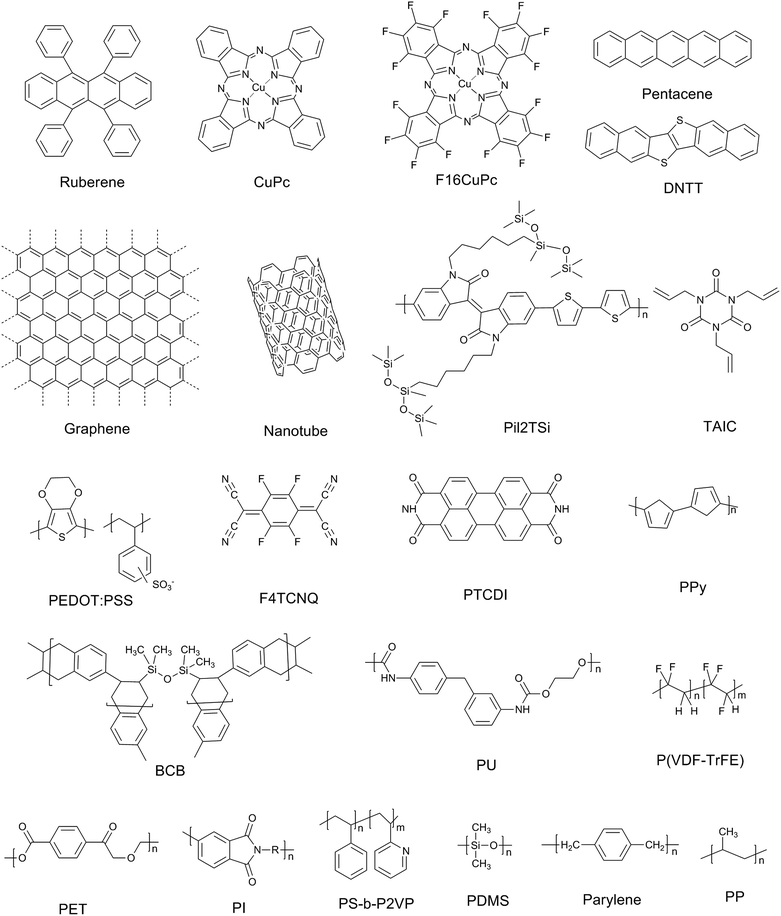Advances of flexible pressure sensors toward artificial intelligence and health care applications
Yaping
Zang
ab,
Fengjiao
Zhang
ab,
Chong-an
Di
*a and
Daoben
Zhu
*a
aBeijing National Laboratory for Molecular Sciences, Key Laboratory of Organic Solids, Institute of Chemistry, Chinese Academy of Sciences, Beijing 100190, China. E-mail: dicha@iccas.ac.cn; zhudb@iccas.ac.cn
bGraduate University of Chinese Academy of Sciences, Beijing 100049, China
First published on 17th October 2014
Abstract
By virtue of their wide applications in personal electronic devices and industrial monitoring, pressure sensors are attractive candidates for promoting the advancement of science and technology in modern society. Flexible pressure sensors based on organic materials, which combine unique advantages of flexibility and low-cost, have emerged as a highly active field due to their promising applications in artificial intelligence systems and wearable health care devices. In this review, we focus on the fundamentals of flexible pressure sensors, and subsequently on several critical concepts for the exploration of functional materials and optimization of sensing devices toward practical applications. Perspectives on self-powered, transparent and implantable pressure sensing devices are also examined to highlight the development directions in this exciting research field.
1. Introduction
Pressure, defined as the ratio of a force to the area over which it exerts, is ubiquitous in basic operations in nature and human society. The Earth's gravity and most physical contact contribute to the generation of pressure. Even inside the human body, regular physiological activities generate various pressures, including blood pressure, intraocular pressure, etc., all of which are significant health indicators. Pressure sensors can generate signals under certain pressures and operate in a manner, namely, signal transduction.1–16 This prominent feature enables the successful application of pressure sensors in personal electronic devices, artificial intelligence and industrial production applications.17–22The rapidly advancing electrical sensing techniques and organic electronics have contributed to significant progress in the development of flexible pressure sensors, which possess unique advantageous properties such as outstanding flexibility, low cost, and compatibility with large-area processing techniques.23–31 In particular, many flexible pressure sensors based on organic materials have been fabricated, and their sensing capacities even surpass human skin, the largest sensory organ with thousands of specialized pressure-sensing receptors.32–36 Through large-area integration of flexible devices, active sensing matrices have been fabricated which tend to be ideal candidates for electronic skin (e-skin) applications.14,25,26,37,38 Interest in integrated networks of sensors is also motivated by the promising applications in intelligent robotics, human–machine interactions, and biomimetic prosthesis, which greatly promote the advancement of artificial intelligence systems.39–45
Mobile biomonitoring in medical diagnostics and health care is another attractive application for pressure sensors.25,26,37,38 The advent of organic material based flexible pressure sensors offers a novel potential opportunity to develop these fantastic applications. Organic material based flexible pressure sensors are not meant to replace silicon-based devices but rather to fill niches in next-generation portable and wearable health care products, for which light weight, low cost, and excellent foldability are highly desired.25,26,37,38,46,47
After years of extensive development, great achievements have been demonstrated in the exploration of functional materials for sensing applications, fabrication of single pressure sensors with high sensitivity, and construction of integrated circuits towards practical applications. In the following sections, we attempt to present a brief overview of recent advances in, and prospects for, flexible pressure sensors. Section 2 is mainly on fundamentals of pressure sensors. In Section 3, we focus on promising applications, and then, material considerations for flexible pressure sensors are discussed in Section 4. Then we address some critical concepts associated with pressure sensors (Section 5), and perspectives on the development of pressure-sensing devices are outlined in the last part of our review.
2. Fundamentals of pressure sensors
At first, we would like to outline the fundamentals of pressure sensors to ensure a thorough understanding of the sensing devices. A detailed discussion of the categorization, key parameters and transduction mechanisms of pressure sensors is provided below.2.1. Categories of pressure sensors
The typical pressures produced by normal touch, object manipulation and human body circulation are mainly distributed in low-pressure regimes (<10 kPa) and medium-pressure regimes (10–100 kPa).14 The detection of these pressures is of great importance for a broad range of applications including wearable health care systems, human–machine interfacing devices, and artificial intelligence.37,48–52 To better understand specific pressure distributions and the relevant sensing devices, we divide pressures below 100 kPa into four ranges: ultra-low-pressure (<1 Pa), subtle-pressure (1 Pa–1 kPa), low-pressure (1–10 kPa) and medium-pressure (10–100 kPa) regimes (Fig. 1).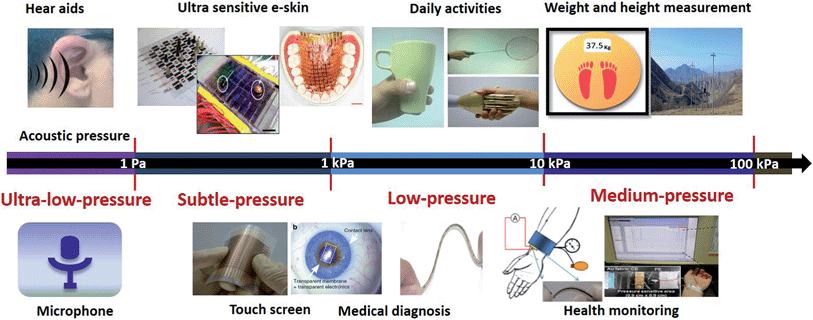 | ||
| Fig. 1 The diagram of pressure regimes and the relevant applications.21,26,43,47–49,51,52,54 Images reproduced with permission from ref. 21, 26, 43, 47–49, 51, 52 and 54. Copyright© 2012, Nature Publishing Group;21 Copyright© 2010, Nature Publishing Group;26 Copyright© 2010, Wiley-VCH;43 Copyright© 2013, Nature Publishing Group;47 2014, Nature Publishing Group;48 Copyright© 2014, Wiley-VCH;49 Copyright© 2004, National Academy of Sciences, USA;51 Copyright© 2010, Wiley-VCH;52 Copyright© 2014, Nature Publishing Group.54 | ||
The range below 1 Pa is defined as the ultra-low pressure regime. Although such ultra-low pressures rarely occur in daily activities, it is still worth noting that sound pressure, which is hardly perceived by typical pressure sensors, is an example of pressure in this range. In fact, the construction of ultra-sensitive pressure sensors plays a significant role in promoting the development of microelectromechanical system (MEMS) microphones, hearing aids, and other intelligent products.53 Many pressures created by weak interactions and small objects exist within the subtle-pressure regime (1 Pa–1 kPa). A sensitive response to subtle pressures in this range is crucial to the development of ultra-sensitive e-skin, which possesses better sensing properties than human skin.21,47,48 Subtle-pressure-sensitive sensors also serve as the foundation for the development of highly sensitive touch screen devices that are widely used in mobile phones.51
The low-pressure regime (1–10 kPa) is a common but important range covering intra-body pressures (e.g., intraocular pressure and intracranial pressure) and pressures experienced on a daily basis that are created by gentle manipulation of items.43,54 Much attention has been paid recently to developing pressure sensors for applications in health care and medical diagnosis systems.26,50,55,56 Sensors that are sensitive in the medium-pressure regime (10−100 kPa) are receiving considerable attention, which has achieved noteworthy progress in applying these sensors in mobile blood and pulse monitor devices.49,52 Static pressures, including the plantar pressure of body weight and atmospheric pressure at high altitudes, are also in the medium-pressure regime. Thus, researchers have been motivated in the innovative development of corresponding portable devices such as wearable barometers integrated into outdoor equipment.
2.2. Key parameters of pressure sensors
A pressure sensor usually acts as a transducer that transforms an imposed force into an electrical signal or other recognized signal output.2 To evaluate the performance of a sensing device, we need essential information about the key parameters associated with pressure sensors. These key parameters include the sensitivity, limit of detection (LOD), linearity, response time, and stability.Sensitivity is one of the most important parameters of pressure sensors because it determines the measurement accuracy and effectiveness of the device. The pressure sensitivity is defined as S = dX/dP, where S is the sensitivity and X and P denote the quantitative output signal and applied pressure, respectively. The LOD, another key performance parameter, is the lowest pressure that produces a distinguishable signal change. This pressure is also called the threshold pressure. Improvement on the LOD of pressure sensors is important to the development of effective ultra-low and subtle-pressure sensors. Linearity is typically defined as the degree to which the actual performance of a pressure sensor across a specified operating scale approximates a straight line. Linearity is usually quantified in terms of the deviation from a straight regression line and is expressed as a percentage. The responses of pressure sensors are more accurate and reliable in the linear operation range. Thus, it is highly desirable for practical applications to create sensitive pressure sensors with broad linear ranges.
The response time is also an important parameter in evaluating the performance of pressure-sensing devices, particularly those used in dynamic real-time sensing. The response time is defined as the time consumption of a pressure sensor during response processes, from inputting pressure to producing a stable signal output. Both advances in instant-response displays and real-time monitoring health care systems require shortening of the response time, and many devices with quick response capabilities (response time <100 ms) have been produced. The operating voltage, which is the voltage required to sustain regular operation of devices, is a critical factor in determining the power consumption. Decreasing the operating voltage and the corresponding power consumption is an indispensable trend of wearable electronic devices. It is worth noting that the parameters mentioned are inseparable in determining the overall performance of pressure sensors.
2.3. Transduction mechanism
Various transduction mechanisms, including piezoresistivity, capacitance, and piezoelectricity, etc., exist for converting tactile stimuli into electrical signals.57–61 Each of these transduction methods has its own characteristics (Fig. 2), the details of which are presented below.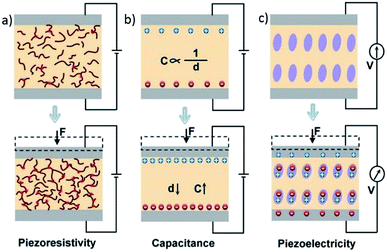 | ||
| Fig. 2 The schematic images of transduction methods: (a) piezoresistivity, (b) capacitance, and (c) piezoelectricity. | ||
OFETs are one of the most thoroughly studied electronic components. A typical OFET structure consists of a semiconductor layer, a gate dielectric layer, source–drain electrodes, and a gate electrode. As a common device structure, the gate dielectric layer is placed between the semiconductor layer and the gate electrode. When a gate voltage is pulsed, charge carriers accumulate at the dielectric/organic layer interface and form a conductive channel, and then current flows from source to drain electrodes upon application of source–drain bias (VDS).23,62,63 During this operating process, the dielectric layer is regarded as a capacitor, the charge status of which is controlled by the gate voltage. For most OFET-based pressure sensors, the sensing mechanism mainly depends on the capacitance change of the dielectric layer. Because of the unique signal amplification function of the OFET, a minute change in capacitance will generate an obvious current signal output, resulting in effective detection of applied pressure with high sensitivity and low power consumption.14,64
3. Promising applications of flexible pressure sensors
Benefitting from their excellent mechanical properties, flexible pressure sensors are considered as excellent candidates for practical electronic applications (Fig. 3). Flexible pressure-sensing technology accelerates the development of touch-sensitive electronic products to a great extent and plays a significant role in emerging artificial intelligence application. Mobile health care and remote medical diagnostics represent the other application field of flexible pressure-sensing devices.39,41–43,45,46,51,69–74 | ||
| Fig. 3 The promising applications of the pressure sensor.14,25,38,43,70,71 (Images reproduced with permission from ref. 14, 25, 38, 51, 70 and 71 Copyright© 2010, Nature Publishing Group;14 Copyright© 2013, Nature Publishing Group;25 Copyright© 2014, Wiley-VCH;38 Copyright© 2010, Wiley-VCH;43 Copyright© 2010, Nature Publishing Group;70 Copyright© 2012, Nature Publishing Group.71) | ||
3.1. Touch sensors for electronic applications
Nearly three decades ago, a personal computer (marketed by Hewlett-Packard) equipped with a touch screen was the first mass-marketed electronic product containing pressure-sensing devices.2 An era of touch-sensitive electronics followed, with the pace of development of these electronics driven by strong industrial interest. In addition to personal computers, there are many other electronic products equipped with touch displays on the market, such as touch-controlled mobile phones, MP3 players, kitchenware, etc. Moreover, various touch displays are installed in automobiles and industrial equipment.Recently, motivated by the wide interest in flexible electronics, researchers have begun utilizing flexible and stretchable electronic materials to fabricate large-area, low-cost pressure sensors.14,43,70 Apart from the first proposed flexible sensor sheets based on integrated etched Si wafers and polyimide foils,75 flexible and even stretchable sensor arrays made from organic active materials emerged at nearly the same time and offered comparable sensing performance. Given these unique properties, flexible touch-sensitive electronic products are garnering attention for use in relevant products.76,77 For example, rollable touch displays are among the main components of new mobile display devices, and companies such as Sony and Nike have recently produced sport bracelets for monitoring exercise. Other sport sensing products with the capacity to monitor human body motions have been used commercially for self-correction during sports.
3.2. Tactile sensors for artificial intelligence applications
Artificial intelligence, which is human-like intelligence displayed by machines and software, is an important research area for flexible pressure sensors.46,69,78,79 The preceding decade has seen great progress in the development of artificial intelligence technologies. As a typical component of artificial intelligence applications, tactile sensor based e-skin that can mimic the complex characteristics of human skin has been extensively investigated. Various types of flexible e-skins have been developed, and most of them exhibit outstanding sensing abilities. Another important application of artificial intelligence is the interactive robot which requires high-performance integration of compliant pressure-sensing devices with computer control and information processing systems. Robotic systems with excellent sensing capabilities could be used to execute highly interactive tasks associated with, for example, caring for the elderly and nursing patients. We do not intend to go into the details of this topic since the related features of the tactile sensor have been well summarized by Hammock et al.23.3. Wearable pressure sensors for health care applications
Health care has received extensive interests. As a primary aspect of health care, monitoring of pulse, blood pressure, and heartbeat is essential for health evaluation. Highly sensitive pressure sensors have been used in the continuous recording of pulse and blood pressure for the collection of fundamental health information.25,38 Recently, wearable health monitoring products have been put on the market and have attracted considerable attention. For example, wearable intelligent bracelets with real-time health monitoring capabilities have been produced and are popular with the public.Sensitive organic pressure sensors featured by light weight, high flexibility, and portable processability are urgently needed for wearable health monitoring devices. Much relevant progress has been made and several groups have demonstrated real-time pulse wave monitoring using flexible piezoresistive devices.21,37,38 Using a carbon nanotube (CNT)–polydimethylsiloxane (PDMS) composite, Lee et al. developed flexible and biocompatible dry electrodes that exhibited good long-term performance in wearable electrocardiographic (ECG) monitoring when connected to traditional ECG devices.80 They also tested continuous wearability and found that the ECG signal did not decrease obviously after seven days of wearing, indicating that the fabricated sensors are suitable for use in long-term wearable healthcare devices. It therefore can be expected that the explosion of flexible pressure sensors will accelerate the development of wearable health monitoring devices towards practical applications.
4. Exploration of functional materials for flexible pressure sensors
To develop sensing components with excellent and comprehensive sensing capabilities, several significant factors should be considered. The application of functional materials that possess superior electronic properties and the utilization of typical transduction methods for interacting with the outer stimulus are two representative aspects. Therefore, it is critical to develop suitable functional materials for pressure sensing applications. The combination of mechanical compliance, appropriate electrical performance, and large-area processing compatibility is crucial for creating highly sensitive flexible pressure sensors.34,47,81–92 We summarized the recent progress in the development of pressure sensors in terms of their transduction methods, active materials, and common performance parameters, including their sensitivity, LOD, response/relaxation time and operating voltage (Table 1). Fig. 4 displays the molecular structures of the organic materials mentioned in this review, e.g., active layers, substrates, dielectric and electrode materials. As shown in Table 1, capacitance, piezoresistivity, and piezoelectricity are the most frequently used methods for signal transduction, while PDMS, rubrene, micro- and nanostructured polymers, and P(VDF-TrFE) copolymers are the most commonly used active materials. Additionally, the key performance parameters of these sensors have been improved dramatically and many outstanding large-area pressure sensors have been created with these materials by constructing various device geometries.| Types of transduction | Materials | Sensitivity | Limit of Detection (LOD) | Response/relaxation time | Operating voltage | Ref. |
|---|---|---|---|---|---|---|
| Capacitance | GaN | 0.0086 kPa−1 | 64 | |||
| Capacitance | Alumina ceramic | 0.0035 kPa−1 | 100 kPa | 35 | ||
| Capacitance/OFET | PS-b-P2VP | 1.76 kPa−1 | <17 kPa | 50 V | 91 | |
| Capacitance/OFET | PDMS/Rubrene | 0.55 kPa−1 | 3 Pa | <10 ms | 80 V | 14 |
| Capacitance/OFET | PDMS/Pil2TSi | 8.4 kPa−1 | <10 ms | 100 V | 25 | |
| Piezoresistivity | Nanohair | 11.35 μS kPa−1 | 5 Pa | 50 ms | 21 | |
| Piezoresistivity | Tissue/Gold nanowires | 1.14 kPa−1 | 13 Pa | <17 ms | 1.5 V | 37 |
| Piezoresistivity | Polypyrrole | 133.1 kPa−1 | 0.8 Pa | 50 ms | 48 | |
| Piezoresistivity | PDMS/Nanotube | 0.23 kPa−1 | 50 kPa | ≤ 125 ms | 42 | |
| Piezoresistivity | Graphene | 100 Pa | 9 s | 2.5 V | 106 | |
| Piezoresistivity | PDMS/SWNTs | 1.8 kPa−1 | 0.6 Pa | <10 ms | 38 | |
| Piezoresistivity/OLED | PSR | 42.7 Cd m−2 kPa−1 | 1 kPa | 1 ms | 10 V | 40 |
| Piezoresistivity | PDMS/PEDOT![[thin space (1/6-em)]](https://www.rsc.org/images/entities/char_2009.gif) : :![[thin space (1/6-em)]](https://www.rsc.org/images/entities/char_2009.gif) PSS/PUD PSS/PUD |
10.32 kPa−1 | 23 Pa | 200 ms | 49 | |
| Piezoresistivity/OFET | Nanowire/PSR | 11.5 kPa−1 | <0.1 s | 5 V | 70 | |
| Piezoelectricity | P(VDF-TrFE) | 13.3 Pa | 1 V | 55 | ||
| Piezoelectricity | PVDF | 2 V kPa−1 | 1 kPa | 10 | ||
| Piezoelectricity | P(VDF-TrFE) | 2.3 kPa−1 | 0.17 s | 33 | ||
| Piezoelectricity | P(VDF-TrFE) | 1.1 V kPa−1 | 0.1 Pa | 69 | ||
| Piezoelectricity | ZnO | 2.1 μS kPa−1 | 3.5 kPa | 0.15 s | 1 V | 45 |
| Piezoelectricity | Polypropylene | 0.001 kPa−1 | 2 Pa | 87 | ||
| Piezoelectricity | Titanate/P(VDF-TrFE) | 6.7 × 10−4 kPa−1 | 200 kPa | 15 V | 93 | |
| Piezoelectricity/OFET | P(VDF-TrFE) | 200 kPa | 5 V | 29 | ||
| Optical waveguide | PDMS | 0.2 kPa−1 | <1 kPa | 300 ms | 32 |
4.1. Substrate materials
For traditional rigid pressure sensors, Si, SiO2, or glass is employed as the substrate, which is not regarded as a key element in determining the device characteristics. However, the substrate material is an important factor in the development of flexible pressure sensors. Both high mechanical flexibility and low roughness are highly desired. Many commercially available polymers and elastomers including PDMS, polyethylene terephthalate (PET), polyimide (PI), polyethylene (PEN), and polyurethane (PU) can serve as substrates for flexible and stretchable electronics.13,47,85PDMS, a commercially available product, is a silicon rubber with a low Young's modulus that can be prepared with readily accessible laboratory techniques.25 The intrinsic flexibility and extensibility of PDMS make corresponding devices respond readily to torsion, tensile and compressive strain. Furthermore, the extensibility of PDMS can be improved by geometric structuring such as the formation of nets and bucking structures to meet the requirements of applications for coplanar devices.94 It should also be noted that PDMS possesses many other advantages such as high transparency and excellent stability over a large temperature range.43 These advantages broaden its applicability as a large-area substrate for transparent electronics and thermally stable devices.
PI has excellent stability, insulating property, and mechanical properties.13 This material can sustain a large temperature range, from −100 to 300 °C, without obvious property changes. It is also invulnerable to corrosion by commonly used chemical solvents, which is important in the subsequent device process steps. Furthermore, even ultrathin PI films are not damaged by high mechanical forces, and its excellent bending stability makes it a suitable candidate for compliant devices. Someya et al. have fabricated many flexible pressure matrices with PI substrates.13,26 By fabricating organic transistors and pressure sensors on a very thin (12.5 μm-thick) PI substrate, they demonstrated a flexible array with a bending radius as small as 100 μm.26 A very thin catheter was thus prepared for measuring the spatial distribution of pressure, demonstrating its potential application in medical diagnosis.
PEN and PET are also considered as promising substrates. For instance, an ultra-lightweight plastic electronic device (3 g cm−2) has been produced with an ultra-thin PEN foil 1 μm thick that can withstand repeated bending to a 5 μm radius and paper-like crumpling.47 By combining pressure-sensitive rubbers with OFETs on a PEN substrate, pressure-sensing matrices have been produced, which indicates their encouraging potentials in e-skin.94
4.2. Active materials
The active layer is the most important component of pressure-sensing devices. The active materials for promising pressure-sensing devices should possess exceptional mechanical and electronic properties.95 The most frequently reported active materials can be classified into three categories: intrinsically highly conductive materials, elastomer conductive composites, and piezoelectric materials. The details of these active materials are discussed below.Graphene, an atomically thin carbon material with remarkable conductivity, is one of the most widely investigated materials in the past few years.96–105 Since recent reviews on graphene have provided details thoroughly on its properties, we discuss only a few examples of its applications in pressure sensors.102,103 In fact, graphene is a promising active material for pressure sensors owing to its superior mechanical and electrical properties.34,106–108 Recent studies carried out by Zhu et al. have demonstrated that graphene can be used as an active layer and an electrode in a pressure sensor.109 Benefiting from this prominent feature, highly flexible all-graphene passive pressure sensors have been reported. More interestingly, the fabricated sensors can sense temperature and pressure simultaneously in a single device. Furthermore, graphene can also serve as a semiconductor, enabling its application in transistor based pressure sensors. As a convincing example, Cho and co-workers recently developed a transparent graphene field-effect transistor (GFET) pressure sensor with a high-capacitance ion gel gate dielectric by construction of a coplanar gate geometry structure.34 The high transparency (∼80%), low power consumption, and low cost made GFET pressure sensors ideal candidates for transparent electronic applications.34
Elastomer composites have attracted increasing attention in the development of flexible and stretchable pressure-sensing matrices.19,57,71,89,93,110 To obtain an ideally stretchable conductor with high conductivity over a large strain range, suitable insulating elastomers and conductive materials are mixed using appropriate methods. The most commonly used elastomer materials are PDMS, sponge, and other porous materials, and the conductive materials are carbon black (CB), CNTs, graphene, and conductive polymers (CPs) such as poly(3,4-ethylenedioxythiophene):polystyrene sulfonate (PEDOT:PSS), polyaniline (PANI), and poly(3-hexylthiophene-2,5-diyl) (P3HT). CNTs are the most successful types of fillers because of their excellent conductivity and high anisotropy.2 Using a template with a sugar lump as a mold, Meyyappan and co-workers fabricated an elastomer scaffold, which subsequently was filled with CNTs.110 Pressure induced increase of conductive pathways contributes to the output signal in the pressure sensing process.110 Kim and co-workers developed porous pressure-sensitive rubber (PPSR) by mixing multi-walled carbon nanotubes (MWNTs), PDMS, and reverse-micelle solution (RMS).19 Compared with traditional PSR-based ones, PPSR based sensors responded to external mechanical inputs with higher sensitivity. By switching the PPSR film with conductive carbon fabric, pressure sensitive clothing was produced. Wearable PPSR-based sensors were also integrated with the skin and used as human–machine interfaces (HMIs) for wireless controlling robotics.19
Recently, a great deal of attention has been devoted to developing highly efficient piezoelectric pressure sensors because of their unique properties such as fast response speed and self-powered operation. Polyvinylidene difluoride (PVDF) based copolymers constitute an important class of frequently used piezoelectric materials in terms of their flexibility and ease of processing.33,69 P(VDF-TrFE) is the most widely applied piezoelectric copolymer and many sensitive tactile sensors based on the P(VDF-TrFE) film have been demonstrated.33,55,69,93 Although inorganic materials possess inferior flexibility when compared to their organic counterparts, many inorganic nanowires (NWs) can exhibit good mechanical flexibility. Therefore, uniform inorganic piezoelectric NW arrays made of zinc oxide ZnO, In2O3, GeSi, GaAs, etc. have been extensively investigated for flexible pressure-sensing devices.45,70,111–115 Wang's group performed systematic studies on ZnO NWs in highly sensitive dynamic pressure sensors.45,115,116 Using ZnO NWs that bridge across two ohmic contacts with source and drain electrodes, three-dimensional (3D) strain-gated piezoelectric field effect transistors can be constructed.115 The force applied to the top electrode affects the electrical characteristics of the devices and contributes to the sensitive pressure detection. Moreover, by integrating these 3D transistors into a 92 × 92 array with a taxel area density of 8464 cm−2, high-resolution tactile imaging and multidimensional active sensing were successfully achieved (Fig. 5).45
 | ||
| Fig. 5 3D strain-gated vertical piezotronic transistor (SGVPT) matrix. (a) Schematic illustration of a three-terminal voltage-gated NW FET. (b) Schematic illustration of a 3D SGVPT array. Color gradient in the strained SGVPT represents the strain-induced piezopotential field, in which red and blue respectively indicate positive and negative piezopotentials. (c) Current responses for different pressures, showing the gate modulation effect of applied pressure on the electrical characteristics of the SGVPT. (d) Statistical investigation of the integrated SGVPT array without applying stress and the current response for imaging the spatial profile of applied stress. The physical shape of the applied stress is highlighted by the white dashed lines. Adapted with permission from ref. 45. Copyright© 2013. AAAS.45 | ||
4.3. Electrodes
There are also some key considerations for electrodes used in flexible pressure sensors. In fact, electrodes can serve as sensitive elements in some pressure sensors. For many piezoresistive devices, the applied stimulus creates a resistance change because of the variation in contact sites between two electrode sheets or electrode–active layer interfaces, generating an effective current signal output. Mechanical flexibility and stability should be taken into account in the exploration of conducting electrodes to achieve flexible sensing devices.Carbon and elastic composite based conductors are preferred for use as electrodes over commonly utilized metals such as Au, Ag, and Cu. For example, CNTs and graphene are outstanding electrode materials because of their high conductivity and mechanical flexibility.101,117 Zhang et al. developed PDMS based sensitive electronic skin using single-walled nanotube (SWNT) electrodes.38 With construction of a face-to-face device structure, pressure-created deformations of contact electrodes and the active layer lead to obvious resistance changes that produce an electrical signal. Composite materials of elastic polymers and conductors are another material category of flexible electrodes. For instance, by coating the elastic electrodes made of PEDOT:PSS and a polyurethane dispersion (PUD) on the surface of a spring-like compressible substrate, the fabricated sensor has a sensitivity of 10.3 kPa−1.49 These results indicated that exploration of electrode materials with excellent mechanical and electrical properties are also in great requirement for flexible pressure sensors.
5. Optimization concepts and recent developments of sensing devices toward practical pressure sensors
Although different pressure sensors exhibit a variety of device characteristics, they have much in common in terms of the categories of functional materials, device structure, interface engineering, etc. Herein, we summarize the key concepts for the construction of pressure sensing devices toward practical applications. Some recent developments of pressure sensors are also included in the following section.5.1. Construction of pressure sensors with optimized performance
Sensitivity is regarded as the most critical parameter in determining the performance of a pressure sensor. Considerable efforts have been devoted to enhancing pressure sensor sensitivity, and a series of highly sensitive pressure sensors have been developed.25,48 We identified the following strategies that may offer a direction for designing and producing highly sensitive pressure sensors.As for piezoresistive sensors, the whole resistance is the sum of three components: the resistance of the electrodes (RE), contact interface (RCI), and piezoresistive active material (RPA),49 as given in eqn (1):
| R = RE + RCI + RPA | (1) |
Many reported devices function based on bulk piezoresistivity (RE + RCI ≪ RPA) and employ conductive composites as the active layer. The Young's modulus, E, determines the material's mechanical properties.85 Materials with intrinsically low elastic moduli are easy to deform and are preferred for use as active materials for pressure sensors. A representative example is PDMS, which has a low elastic modulus of 106 Pa and which is widely utilized in pressure sensors with outstanding sensitivity.85 Various types of piezoresistive pressure sensors have been fabricated with PDMS active layers, and among them, face-to-face device structures consisting of two conducting electrode-coated PDMS sheets are commonly used.38 When a force is applied, the deformation-induced change in contact resistance results in a current signal variation and the detection of the corresponding force.
The sensing performance of most piezoresistive devices is usually limited by the bulk mechanical properties of the rubber utilized. As a result, poor sensitivity owing to a relatively large modulus and slow response speed due to viscoelasticity are two existing problems for such kinds of piezoresistive sensors.48 A possible approach to resolve the problem relies on the utilization of nano- and/or micro-structured active materials, which can contribute to dramatically changed contact resistance under external pressure.49,108 Recently, Yu and co-workers fabricated a flexible and highly sensitive pressure sensor based on a graphene-wrapped polyurethane sponge (Fig. 6a).108 The mechanism of these sensors depends primarily on piezoresistive changes caused by conductive nanofibers during compression. By creating a contact fractured microstructure, the sensitivity of the graphene-wrapped PU sponge was enhanced by nearly two orders of magnitude in the 0–2 kPa pressure range and one order of magnitude in the 2–10 kPa pressure range compared with that of the original device (Fig. 6b and c). The improved sensitivity along with the prominent stability of microstructured sponge pressure sensors makes it a promising candidate for low-cost applications.
 | ||
| Fig. 6 Microstructured active materials based pressure sensors. (a) SEM images of the RGO-PU sponge, hydrothermally treated RGO-PU sponge (RGO-PU-HT), and the compressed treated RGO-PU-HT sponge (RGO-PU-HT-P). (b) The plots of contact pair number–compressive stress response curves for the fiber network with or without pre-compression under different fiber fracture ratios, respectively. (c) Pressure response curves for RGO-PU sponges and RGO-PU-HT-P sponges. Adapted with permission from ref. 108. Copyright© 2013. Wiley-VCH.108 | ||
Utilization of the contact resistance between two electrodes or the electrode-active layer interface represents another sensing mechanism to improve the sensitivity of piezoresistive sensors. Since the contact resistance is significantly affected by the contact area, construction of pressure sensitive contact between two electrode sheets can be used to improve the sensitivity of the pressure sensing devices. Chung et al. developed highly stretchable resistive pressure sensors based on a conductive elastomeric composite on a micropyramid PDMS array (Fig. 7a).49 Using a composite of PEDOT:PSS and PUD as stretchable electrodes coated on micropyramid PDMS arrays, the contact resistance changes dramatically upon pressure, which contribute to the sensitive detection of applied pressure. The fabricated devices exhibit a sensitivity of 10.3 kPa−1 even stretched by 40%.49 The high sensitivity allows the successful measurement of the primary features of a human pulse waveform, demonstrating its promising application in wearable devices.
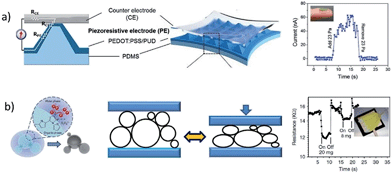 | ||
| Fig. 7 Piezoresistive pressure sensors. (a) Circuit model of the PEDOT:PSS/PUD coated micropyramid array based pressure sensors and the real-time response plot of loading and unloading at a pressure of 20 Pa. Adapted with permission from ref. 49. Copyright© 2014. Wiley-VCH.49 (b) Schematic illustration of the synthesis mechanism of hollow-sphere microstructured PPy hydrogels, the pressure response process and the real-time response plot of loading and unloading of a 20 mg weight and a flower petal. Adapted with permission from ref. 48. Copyright© 2014. Nature Publishing Group.48 | ||
In principle, a pressure sensor with an electrode contact sensing mechanism offers the potential advantages of high sensitivity, a rapid transient response, and a large working range.21,48,118 However, such kinds of devices usually possess unstable contact in the ultra-low-pressure regime due to the lack of an elastic component and exhibit an unsatisfactory LOD.48 This problem can be resolved by the introduction of a microstructured conductive composite with excellent elastic properties. By a combination of synthesis of interconnected hollow-sphere structured polypyrrole (PPy) and fabrication of a PPy film with a microstructured surface, researchers in Bao's group constructed an ultra-sensitive PPy based pressure sensor (Fig. 7b).48 An unprecedented sensitivity of 133 kPa−1 and a low LOD of 0.8 Pa, surpassing the subtle-pressure-sensing properties of human skin, are successfully achieved. The constructed devices, with the advantages of ultra-high sensitivity, a wide dynamic range, rapid response time and temperature-stable operation, will meet the application requirements of a vast variety of fields, such as human–computer user interface, robotics, and industrial monitoring.
For the capacitive pressure sensor, the capacitance is determined by the relative permittivity (εr), area (A) and the distance between the electrodes (d). All these variables (εr, A, and d) can be sensitive to changes in pressure. The changes in d are commonly used to the detection of the normal forces.2 When a pressure sensitive rubber such as a PDMS layer is used as the dielectric layer between two electrodes, effective detection of the applied pressure can be achieved.42 However, the sensitivity of the capacitive sensor with elastomeric dielectrics is limited by the compressibility of rubbers.14 Incorporating a microstructured rubber dielectric with a transistor geometry can contribute to great improvement of device sensitivity of the capacitive pressure sensor because: (i) application of the microstructured rubber dielectric leads to obviously enhanced capacitance changes upon pressure, and (ii) the integrated transistor functions as an amplifier to bring about much improved sensitivity. Based on this strategy mentioned above, Bao et al. fabricated organic transistor based pressure sensors with both rubrene crystals and spin-coated Pil2tSi thin films (Fig. 8).14,25 Taking a flexible thin film transistor for example, a maximum sensitivity of 8.4 kPa−1, a fast response time of <10 ms, high stability over >15![[thin space (1/6-em)]](https://www.rsc.org/images/entities/char_2009.gif) 000 cycles and a low power consumption of <1 mW, were realized. More importantly, the organic transistor based pressure sensor can be used for non-invasive, high fidelity and continuous radial artery pulse wave monitoring, which may lead to the application of the flexible pressure sensor in mobile health monitoring and remote diagnostics.
000 cycles and a low power consumption of <1 mW, were realized. More importantly, the organic transistor based pressure sensor can be used for non-invasive, high fidelity and continuous radial artery pulse wave monitoring, which may lead to the application of the flexible pressure sensor in mobile health monitoring and remote diagnostics.
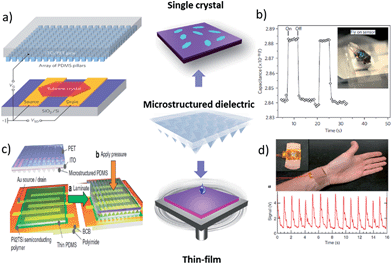 | ||
| Fig. 8 Microstructured PDMS dielectric based OFET pressure sensors. (a) Schematic of a rubrene crystal based OFET sensor. (b) The microstructured PDMS films are able to respond to the very small pressures. Shown is the capacitance change on applying and removing a blue bottle fly (20 mg) on a 64 mm2 area of array, corresponding to a pressure of only 3 Pa. Adapted with permission from ref. 14. Copyright© 2010. Nature Publishing Group.14 (c) Schematic of a polymer based OFET sensor. (d) The photograph of the wrist with a microstructured pressure sensor for pulse wave testing of the radial artery (up) and the obtained real-time transient signal of pulse wave (down). Adapted with permission from ref. 25. Copyright© 2013. Nature Publishing Group.25 | ||
5.2. Reducing power consumption and manufacturing costs of flexible pressure sensors
Low power consumption is of great importance for fabricating wearable pressure sensors that can operate for long periods of time. Depending on the category of pressure sensors, the power consumption varies from a few microwatts to several milliwatts. The power consumption P of a typical piezoresistive sensor can be expressed as P = U2/R, where U and R represent the applied voltage and resistance of the pressure sensor, respectively. In principle, a low operating voltage and an appropriate resistance are preferred to ensure low power consumption. However, many piezoresistive sensors with high conductive active materials have been demonstrated with low energy consumption. A representative example is the sensitive pressure sensor made of ultrathin gold nanowires.37 Benefiting from the high conductivity of gold nanowire, a low voltage of 1.5 V is sufficient to drive the device. Moreover, the whole resistance of the device is determined by the contact area upon pressure and the sensor possesses high resistance when the pressure is unloaded. A low operating voltage and high resistance contribute to a low energy consumption of <30 μW.In comparison with piezoresistive sensors, capacitive sensors possess a unique feature of low power consumption. Further reduction of power consumption mainly relies on the reduction of operating voltage. For OFET-based pressure sensors, decreasing the thickness of the dielectric layer and utilizing materials with high dielectric constants can lead to enhanced capacitance of dielectrics, and thereby decreased operation voltage and reduced power consumption. Unfortunately, most reported OFET based sensors have high operating voltage >60 V.14 Therefore, application of low-operating voltage OFETs under flexible pressure will serve as a strategy towards ultra-low power consumption applications.
A major limitation of aforementioned pressure sensors is that they all need an external power supply to generate an electrical signal for characterization of the devices.68 A self-powered pressure sensor is believed to be one of the ultimate approaches to solve the problem. For piezoelectric and triboelectric pressure sensors, a voltage signal in response to physical contact can be generated, enabling self-powered operation.3,69,119,120 One interesting example is the piezoelectric devices based on aligned arrays of PVDF nanofibers.69 The fabricated devices exhibited high sensitivity even at an exceptionally small pressure of 0.1 Pa (Fig. 9a–b). Another self-powered tactile sensor fabricated by Wang et al. is based on the mechanism of contact electrification.67,68 Enabled by the unique sensing mechanism and surface modification by aligned polymer nanowires, the triboelectric sensor shows an exceptional pressure sensitivity of 44 mV Pa−1 and a maximum touch sensitivity of 1.1 V Pa−1 in the extremely low-pressure region (<0.15 kPa) (Fig. 9c–d).68 These prominent properties, together with electric generation ability during device deformation, allow various potential applications in self-powered micro-mechanical elements.
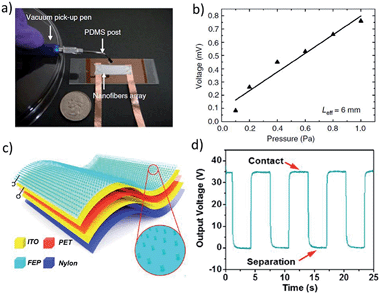 | ||
| Fig. 9 Self-powered pressure sensors. (a) Photograph of the manipulator used to apply pressures, for studying the voltage response. (b) Experimental (symbols) pressure response curve in the low-pressure regime (0.1–1 Pa). Adapted with permission from ref. 69. Copyright© 2013. Nature Publishing Group.69 (c) Schematic illustration of the TES. Inset: enlarged schematic of polymer nanowires on the top surface. (d) Output voltage at a contact pressure of 0.03 kPa from a TES (5 cm in side length) when sensing a metal object (2.5 cm in side length). Adapted with permission from ref. 68. Copyright© 2014. ACS publications.68 | ||
To achieve low-cost construction of flexible pressure sensors for practical applications, a simple device structure and an easy fabrication process compatible with solution processing techniques are extremely desirable. Many simple-structured piezoresistive pressure sensors have been developed, and their cost-effective feature for large area fabrication has been demonstrated. An interesting example is utilization of a patterned PDMS conducting thin film for pressure sensing application.38 It should be noted that the high-quality textiles made of silk which possess microstructured surface intertexture are used as effective moulds for the construction of patterned flexible PDMS films, enabling low-cost fabrication of flexible sensitive e-skin. In addition, the compatibility of organic materials with solution processing techniques including spin coating, spray coating, inkjet printing, etc., promotes progress in the development of low-cost pressure sensors.
5.3. Endowing pressure sensors with additional desired properties: from single functional sensors to multifunctional devices
Apart from specific pressure-sensitive sensors, pressure sensors with additional properties are highly desired to construct e-skin that can sense a series of environmental signals including pressure, strain, temperature, etc. In this part, we highlight three additional desired properties of pressure sensors towards e-skin applications.The self-healing device, a device that possesses exciting ability to repair itself after incurring mechanical damage, has attracted attention and its application has yet to be fully realized in artificial skin. In general, materials loaded with healing agents and containing dynamic reversible bonds are ideal candidates for use in self-healing electronics.2 Incorporating self-healing materials with pressure sensing properties could allow fabrication of self-healing pressure sensors for e-skin application. Benefiting from the development of rubber like conductive composite materials, which is formed with nickel microparticles embedded in a hydrogen-bonded polymer matrix, Bao et al. developed pressure- and flexion-sensitive e-skins (Fig. 10).71 After being ruptured, the initial conductivity of the materials was restored to approximately 90% efficiency after nearly 15 s of healing time. Even a scar created by superficial damage was fully healed after 5 min at 50 °C. The outstanding self-healing capabilities of flexible devices expand their range of applicability in intelligent pressure sensing systems.
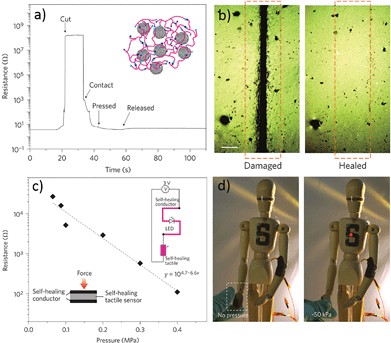 | ||
| Fig. 10 Self-healing pressure sensors. (a) Time evolution of the electrical healing process using resistance measurements for 15 s healing time at room temperature. (b) Optical microscopy images of a damaged sample and complete scar healing. (c) Tactile sensor response at increasing peak pressure values. (d) LED eyes light up after the elbow is bent. Adapted with permission from ref. 71. Copyright© 2012. Nature Publishing Group.71 | ||
To mimic the complex characteristics of human sensing elements, electric tactile sensors should respond to external pressures sensitively and possess the ability to differentiate among various mechanical forces, including shear, torsion, bending, and strain, all of which are commonly produced during the interactions between humans and their surroundings. Cheng and co-workers have developed wearable pressure sensors using ultrathin gold nanowires (Fig. 11a) by sandwiching tissue paper impregnated by ultrathin gold nanowires between two PDMS films.37 An interesting phenomenon is that the device can differentiate among pressing, bending, and torsional forces effectively (Fig. 11b). By employing interlocked, metal-coated, polyurethane-based nanofibers attached to PDMS layers, Suh et al. fabricated flexible and highly sensitive strain-gauge sensors that can respond to multiple mechanical loadings, including pressure, shear, and torsion (Fig. 11c and d).21 Through the use of the high-aspect-ratio (high-AR) nanofibers, each nanoscale deformation created by an external stimulus is converted into a different electrical resistance signal. It is worth noting that each stimulus in the form of pressure, shear, or torsion leads to a unique, discernible magnitude and pattern of the signal obtained. The successful detection of these three different mechanical loads with high sensitivity and a wide dynamic sensing range indicates that these sensors possess the potential for use in artificial intelligence applications.
 | ||
| Fig. 11 Gauge sensors for different types of forces. (a) Schematic illustration of the Au nanowired based device and the sensing mechanism. (b) The response plots of dynamic loading and unloading cycles: pressing (left), bending (middle), and torsion (right). Adapted with permission from ref. 37. Copyright© 2014. Nature Publishing Group.37 (c) Schematic illustration of an assembly interlocked flexible sensor layer sandwiched between thin PDMS supports. (d) Schematic illustration of the pressure, shear and torsion loads and their possible geometric distortions of the paired hairs. Adapted with permission from ref. 21. Copyright© 2012. Nature Publishing Group.21 | ||
Real-time monitoring of environmental and body temperatures, along with gathering of relevant pressure information, is of great value in health care, medical diagnosis, and intelligent robotics. Therefore, sensing temperature is a critical function for advanced and intelligent pressure sensors. Several groups have implemented piezoelectric/pyroelectric sensors that can respond to and discriminate between pressure and temperature.39,78 Using an FET sensor platform integrated with multi-stimuli-responsive materials as subcomponents of the gate dielectrics (piezopyroelectric material) and channel (piezothermoresistive organic semiconductor), Park et al. produced a flexible bimodal sensor array for sensing pressure and temperature simultaneously and disproportionally (Fig. 12a–c).78 Someya et al. developed conformable, flexible, large-area networks of thermal and pressure sensors using an organic transistor-based active matrix (Fig. 12d–f).39 Simultaneous measurements of pressure and temperature distributions have been accomplished by integrating two net-structured sensing arrays. These advances in bimodal sensor technology make it possible for electronic pressure sensors to more closely mimic the functions of their natural counterparts.
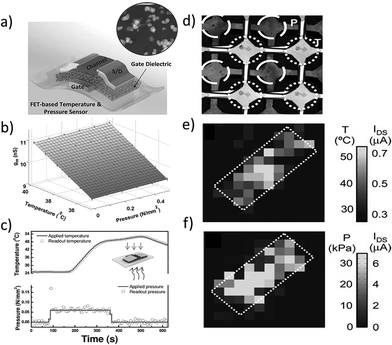 | ||
| Fig. 12 Pressure and temperature sensors. (a) The structure of a physically responsive field-effect transistor (physi-FET), where the gate dielectric is comprised of P(VDF-TrFE) or a nanocomposite of P(VDF-TrFE) and BaTiO3 nanoparticles and the channel organic semiconductor is pentacene. (b) Responses of channel trans-conductance in a FET structure with highly crystalline P(VDF-TrFE) when applying pressure and temperature simultaneously. (c) Demonstration of real-time bimodal sensing of P–T. Adapted with permission from ref. 78. Copyright© 2013. Wiley-VCH.78 (d) A possible implementation of thermal and pressure sensor films. (e) The spatial distribution of temperature that is converted from the temperature dependent current in the thermal sensor network. (f) The spatial distribution of pressure which is measured with the pressure sensor network. Adapted with permission from ref. 39. Copyright© 2005. National Academy of Sciences, USA.39 | ||
5.4. Building pressure sensors into integrated device circuits
The construction of device matrices and circuits is essential for most sensing applications. In general, the integration of pressure sensors was used to fulfill two purposes. The first one is fabrication of a two-dimensional active matrix array of detectors for large area sensing applications. The fabrication of pressure sensor arrays has been achieved to demonstrate their potential application in various fields.26,47,50 Another purpose is the integration of pressure sensors with OFETs, OLEDs, solar cells, radio frequency inductors, capacitors, and thermal electronic devices into one unit that can exhibit a combined property for a unique application. Such a kind of integration represents an effective strategy to explore novel applications of pressure sensing devices.Advances in functional materials and processing techniques promote the development of large-area active matrices that are integrated with pressure sensing devices.36,44,69,83,113,121 Someya's group has carried out systematic studies on integrated circuits based on OFETs and pressure sensors. In 2004, they proposed a flexible, large-area pressure matrix made of organic transistors and pressure sensitive rubbers.51 The superior bendability of this 2 mm-thick material makes it a suitable candidate for use in human-sized robot fingers. Thereafter, another type of e-skin using organic transistor-based stretchable, flexible, large-area pressure matrices was proposed.39 The net-like structure of the fabricated e-skin can be stretched by 25%. By integrating a thermal sensor network in this e-skin, the electronic circuits can detect pressure and temperature simultaneously. Recently, with the integration of a floating gate with organic transistors, nonvolatile memory flexible pressure sensor arrays with pixels that can store information from elements locally have been constructed successfully.44 In capturing some transient events, which may be shorter in duration than the readout time of sensor arrays, local memory plays a significant role and offers a “snapshot” of an instantaneously applied stimulus. Even more exciting work is the demonstrated imperceptible plastic devices on an ultrathin PEN foil (1 μm thick), containing integrated circuits and sensing devices.47 By integrating 12 × 12 pressure-sensitive rubbers with a switching ultrathin OFET matrix, ultralight resistive tactile sensor arrays were produced (Fig. 13a). Distributed pressure sensing has been accomplished with these sensing matrices. These integrated plastic-like electronics, with a total thickness of 2 μm, can be widely applied in mobile electronic appliances, robotics, emergency response, and healthcare systems.47
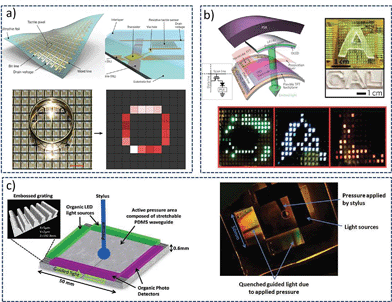 | ||
| Fig. 13 Integrated pressure sensor arrays. (a) Schematic illustration of a thin large-area active-matrix sensor with 12 × 12 tactile pixels, photograph and the corresponding drain current of a metallic ring placed on the sensing sheet. Adapted with permission from ref. 47. Copyright© 2014.47 Nature Publishing Group. (b) Schematic illustration of a single device which is vertically integrated by a nanotube TFT, an OLED and a pressure sensor (PSR) on a polyimide substrate, colour interactive e-skins are used to spatially map and display the pressure applied with C-, A- and L-shaped PDMS slabs. Adapted with permission from ref. 40. Copyright© 2013. Nature Publishing Group.40 (c) Schematic illustration of the two-directional stretchable optical pressure sensor and the picture of this sensor. Adapted with permission from ref. 32. Copyright© 2012. Wiley-VCH.32 | ||
Till now, most investigations on pressure sensors have focused on the optimization of pressure sensors interfaced with an electronic readout, whereas user interfaces based on a human-readable output was rarely reported.40 An appropriate approach to resolve the problem is the integration of pressure sensing elements with light emitting devices. Javey et al. demonstrated a user-interactive e-skin that not only spatially maps the applied pressure but also provides an instantaneous visual response through a built-in active-matrix OLED driven by nanotube based transistors.40 More importantly, in the constructed pressure sensing system, OLED pixels can be turned on locally where the surface is touched, and the intensity of the emitted light quantified the magnitude of the applied pressure (Fig. 13b). Integration of OLEDs and organic photodiodes (OPDs) on a flexible transparent PDMS film (600 μm in thickness) represents another way towards “visible” detection of applied pressure (Fig. 13c).32 The realization of a high sensitivity of 0.2 kPa−1 relies on two phenomena: (i) the compression of the PDMS waveguide layer upon applying a pressure, and (ii) the out-coupling of the waveguided light at the pressure position. Such kinds of highly integrated user-interactive devices not only are spatially visualized under applied pressures but also have promising applications in interactive input/control devices.
6. Conclusions and perspectives
After rapid development of pressure sensors in the past few decades, tremendous progress has been made which allowed pressure sensors to be used in actual electronic applications. More importantly, inspired by the booming development of organic electronics, the flexible pressure-sensing devices with sensitive response capabilities have advanced in an unprecedented fashion. E-skins with significantly improved properties have been demonstrated in artificial intelligence systems. Ultra-sensitive flexible and stretchable pressure sensors are now believed to be ideal candidates for wearable health monitoring applications. All these achievements, as well as their potential applications, enable flexible pressure sensors to be an indispensable part of future electronics.Despite the progress described above, many challenges still lie ahead before implementation of flexible pressure sensors in practical applications. Based on the key considerations outlined, great attention has been centered on improvement of sensitivity by the utilization of newly developed functional materials and optimization of device geometries. However, the overall performance parameters for pressure sensors, i.e., sensitivity, LOD, linearity, and stability, determine their actual application. It is a great challenge to develop a pressure sensor with excellent performance with respect to all these parameters. Moreover, low-cost flexible pressure sensors with ultra-low power consumption are highly desired. Last but not least, a better understanding of the fundamental sensing mechanism and exploration of a novel sensing mechanism deserve great attention to guide the construction of high performance flexible pressure sensors.
Apart from the developments mentioned, there are bright prospects for pressure sensors towards artificial intelligence and health care applications. To meet this key goal and open up new opportunities for pressure sensors, the investigation of flexible pressure sensor development might focus on (i) realization of ultra-sensitive devices, (ii) achievement of high performance self-powered pressure sensors, (iii) construction of transparent pressure sensors, and (iv) fabrication of pressure sensors with featured properties.
Fabrication of ultra-sensitive sensors is an essential project for most applications of flexible pressure sensors. Although many sensitive pressure sensors have been previously demonstrated,25,48 real-time detection of ultra-low sound pressures (<1 Pa) has been rarely reported. Moreover, the mechanisms of most flexible pressure sensors are concentrated to piezoresistive, capacitive, or piezoelectric changes induced by external pressure. Therefore, a novel mechanism should be explored to achieve ultra-sensitive pressure sensors to meet the requirements of future healthcare-detection and super e-skin applications.
Construction of pressure sensors with low power consumption is always an exciting but challenging subject. Developing self-powered sensing devices represents a significant step forward for achieving sustainability in pressure sensors. By combining the sensing components with energy generation units such as organic solar cells and thermoelectric devices, etc., self-powered pressure sensors, which can run continuously with no need for an external power supply, might be produced. An even more exciting feature of self-powered devices is that they directly hybridize the energy generation process and the sensing process into one. Such a kind of self-powered operation has been achieved by piezoelectric and triboelectric pressure sensors. An organic thermoelectric material based pressure sensor, which can utilize the energy generated from the applied temperature difference across the device, might represent another outstanding candidate for self-powered sensing applications.
Transparent touch screen and artificial intelligence applications have been predicted as an important driving force for flexible pressure sensors. Many well-known transparent conducting materials including inorganic oxides, CNTs and graphene have been demonstrated. An important step has been undertaken towards highly transparent pressure sensors, as reflected by a very recent achievement of skin-like pressure sensors with a transparency of more than 80%.42 Further investigation of such kinds of “invisible” pressure sensors could offer new opportunities for wearable and security applications.
Incorporation of the novel emerged technology of organic electronics into previously reported pressure sensors can contribute to realization of new featured sensing devices. Pressure sensors with self-healing properties, a unique feature of human skin, is currently being developed to allow automatic reparation of their mechanical and electric damage for the next generation of e-skin. Implantable pressure sensors are also in great demand and have attracted increasing interest along with rapid development of biocompatible materials. The near future development of pressure sensors is also moving from single functional devices toward multifunctional sensors, which can realize the detection of different signals with one device. All these possible achievements can make flexible pressure sensors an exciting field.
In summary, significant achievements have been made in pressure sensors. A combination of pressure sensors and organic electronic devices, featuring excellent flexibility, outstanding transparency and prominent light-weight properties, will make flexible pressure sensors a fascinating area. Although concerted efforts should be made toward realistic applications, the rapid development of flexible pressure sensors implies the coming new era of wearable electronics and intelligent systems.
Acknowledgements
This research was financially supported by the Major State Basic Research Development Program (2013CB632500), the Strategic Priority Research Program of the Chinese Academy of Sciences (XDB12010000), and the National Natural Science Foundation (21422310, 61171055 and 21333011).Notes and references
- S. H. Nam, P. J. Jeon, S. W. Min, Y. T. Lee, E. Y. Park and S. Im, Adv. Funct. Mater., 2014, 24, 4413 CrossRef.
- M. L. Hammock, A. Chortos, B. C. Tee, J. B. Tok and Z. Bao, Adv. Mater., 2013, 25, 5997 CrossRef CAS PubMed.
- Y. Hu, C. Xu, Y. Zhang, L. Lin, R. L. Snyder and Z. L. Wang, Adv. Mater., 2011, 23, 4068 CrossRef CAS PubMed.
- B. Lamia, J. L. Teboul, X. Monnet, D. Osman, J. Maizel, C. Richard and D. Chemla, Intensive Care Med., 2007, 33, 1931 CrossRef PubMed.
- Y. Rozenman, R. S. Schwartz, H. Shah and K. H. Parikh, J. Am. Coll. Cardiol., 2007, 49, 784 CrossRef PubMed.
- D. Zheng and A. Murray, J. Biomech., 2009, 42, 1032 CrossRef PubMed.
- J. Liu and C. J. Roberts, J. Cataract Refractive Surg., 2005, 31, 146 CrossRef PubMed.
- A. Mahmud and J. Feely, J. Hum. Hypertens., 2000, 14, 541 CAS.
- B. Dahlöf, P. S. Sever, N. R. Poulter, H. Wedel, D. G. Beevers, M. Caulfield, R. Collins, S. E. Kjeldsen, A. Kristinsson, G. T. McInnes, J. Mehlsen, M. Nieminen, E. O'Brien and J. Östergren, J.-Lancet, 2005, 366, 895 CrossRef.
- A. B. Joshi, A. E. Kalange, D. Bodas and S. A. Gangal, Mater. Sci. Eng., B, 2010, 168, 250 CrossRef CAS PubMed.
- R. H. Fagard, Med. Sci. Sports Exercise, 2001, 484 CrossRef PubMed.
- F. M. Sacks, L. P. Svetkey, W. M. Vollmer, L. J. Appel, G. A. Bray, D. Harsha, E. Barzanek and P. R. Conlin, N. Engl. J. Med., 2001, 344, 3 CrossRef CAS PubMed.
- K. Kuribara, H. Wang, N. Uchiyama, K. Fukuda, T. Yokota, U. Zschieschang, C. Jaye, D. Fischer, H. Klauk, T. Yamamoto, K. Takimiya, M. Ikeda, H. Kuwabara, T. Sekitani, Y. L. Loo and T. Someya, Nat. Commun., 2012, 3, 723 CrossRef PubMed.
- S. C. B. Mannsfeld, B. C.-K. Tee, R. M. Stoltenberg, C. V. H.-H. Chen, S. Barman, B. V. O. Muir, A. N. Sokolov, C. Reese and Z. Bao, Nat. Mater., 2010, 9, 859 CrossRef CAS PubMed.
- L. Liu, H. Zhang, Q. Zhao, Y. Liu and F. Li, Opt. Fiber. Technol., 2007, 13, 78 CrossRef PubMed.
- S. Xu, Y. Zhang, L. Jia, K. E. Mathewson, K. I. Jang, J. Kim, H. Fu, X. Huang, P. Chava, R. Wang, S. Bhole, L. Wang, Y. J. Na, Y. Guan, M. Flavin, Z. Han, Y. Huang and J. A. Rogers, Science, 2014, 344, 70 CrossRef CAS PubMed.
- W. Y. Chang, C. C. Chen, C. C. Chang and C. L. Yang, Sensors, 2014, 14, 6922 CrossRef PubMed.
- W. Y. Chang, T. H. Fang, S. H. Yeh and Y. C. Lin, Sensors, 2009, 9, 1188 CrossRef PubMed.
- S. Jung, J. H. Kim, J. Kim, S. Choi, J. Lee, I. Park, T. Hyeon and D. H. Kim, Adv. Mater., 2014, 26, 4825 CrossRef CAS PubMed.
- A. Kang, J. Lin, X. Ji, W. Wang, H. Li, C. Zhang and T. Han, Sens. Actuators, A, 2012, 187, 141 CrossRef CAS PubMed.
- C. Pang, G.-Y. Lee, T.-i. Kim, S. M. Kim, H. N. Kim, S.-H. Ahn and K.-Y. Suh, Nat. Mater., 2012, 11, 795 CrossRef CAS PubMed.
- C. Jiang, S. Markutsya, Y. Pikus and V. V. Tsukruk, Nat. Mater., 2004, 3, 721 CrossRef CAS PubMed.
- C. A. Di, F. J. Zhang and D. B. Zhu, Adv. Mater., 2013, 25, 313 CrossRef CAS PubMed.
- J. A. Rogers, Z. Bao, K. Baldwin, A. Dodabalapur, B. Crone, V. R. Raju, V. Kuck, H. Katz, K. Amundson, J. Ewing and P. Drzaic, Proc. Natl. Acad. Sci. U. S. A., 2001, 98, 4835 CrossRef CAS PubMed.
- G. Schwartz, B. C. Tee, J. Mei, A. L. Appleton, H. Kim do, H. Wang and Z. Bao, Nat. Commun., 2013, 4, 1859 CrossRef PubMed.
- T. Sekitani, U. Zschieschang, H. Klauk and T. Someya, Nat. Mater., 2010, 9, 1015 CrossRef CAS PubMed.
- H. Wang, C. Cheng, L. Zhang, H. Liu, Y. Zhao, Y. Guo, W. Hu, G. Yu and Y. Liu, Adv. Mater., 2014, 26, 4683 CrossRef CAS PubMed.
- Y. P. Zang, F. J. Zhang, D. Z. Huang, C. A. Di, Q. Meng, X. K. Gao and D. B. Zhu, Adv. Mater., 2014, 26, 2862 CrossRef CAS PubMed.
- T. Q. Trung, N. T. Tien, Y. G. Seol and N.-E. Lee, Org. Electron., 2012, 13, 533 CrossRef CAS PubMed.
- I. Manunza and A. Bonfiglio, Biosens. Bioelectron., 2007, 22, 2775 CrossRef CAS PubMed.
- J. Reeder, M. Kaltenbrunner, T. Ware, D. Arreaga-Salas, A. Avendano-Bolivar, T. Yokota, Y. Inoue, M. Sekino, W. Voit, T. Sekitani and T. Someya, Adv. Mater., 2014, 26, 4967 CrossRef CAS PubMed.
- M. Ramuz, B. C. Tee, J. B. Tok and Z. Bao, Adv. Mater., 2012, 24, 3223 CrossRef CAS PubMed.
- T. Sharma, S.-S. Je, B. Gill and J. X. J. Zhang, Sens. Actuators, A, 2012, 177, 87 CrossRef CAS PubMed.
- Q. Sun, D. H. Kim, S. S. Park, N. Y. Lee, Y. Zhang, J. H. Lee, K. Cho and J. H. Cho, Adv. Mater., 2014, 26, 4735 CrossRef CAS PubMed.
- Q. Tan, C. Li, J. Xiong, P. Jia, W. Zhang, J. Liu, C. Xue, Y. Hong, Z. Ren and T. Luo, Sensors, 2014, 14, 2417 CrossRef CAS PubMed.
- S. Yun, S. Park, B. Park, Y. Kim, S. K. Park, S. Nam and K. U. Kyung, Adv. Mater., 2014, 26, 4474 CrossRef CAS PubMed.
- S. Gong, W. Schwalb, Y. Wang, Y. Chen, Y. Tang, J. Si, B. Shirinzadeh and W. Cheng, Nat. Commun., 2014, 5, 3132 Search PubMed.
- X. Wang, Y. Gu, Z. Xiong, Z. Cui and T. Zhang, Adv. Mater., 2014, 26, 1336 CrossRef CAS PubMed.
- T. Someya, Y. Kato, T. Sekitani, S. Iba, Y. Noguchi, Y. Murase, H. Kawaguchi and T. Sakurai, Proc. Natl. Acad. Sci. U. S. A., 2005, 102, 12321 CrossRef CAS PubMed.
- C. Wang, D. Hwang, Z. Yu, K. Takei, J. Park, T. Chen, B. Ma and A. Javey, Nat. Mater., 2013, 12, 899 CrossRef CAS PubMed.
- D. H. Kim, N. Lu, R. Ma, Y. S. Kim, R. H. Kim, S. Wang, J. Wu, S. M. Won, H. Tao, A. Islam, K. J. Yu, T. I. Kim, R. Chowdhury, M. Ying, L. Xu, M. Li, H. J. Chung, H. Keum, M. McCormick, P. Liu, Y. W. Zhang, F. G. Omenetto, Y. Huang, T. Coleman and J. A. Rogers, Science, 2011, 333, 838 CrossRef CAS PubMed.
- D. J. Lipomi, M. Vosgueritchian, B. C.-K. Tee, S. L. Hellstrom, J. A. Lee, C. Fox and Z. Bao, Nat. Nanotechnol., 2011, 6, 788 CrossRef CAS PubMed.
- T. Sekitani and T. Someya, Adv. Mater., 2010, 22, 2228 CrossRef CAS PubMed.
- T. Sekitani, T. Yokota, U. Zschieschang, H. Klauk, S. Bauer, K. Takeuchi, M. Takamiya, T. Sakurai and T. Someya, Science, 2009, 326, 1516 CrossRef CAS PubMed.
- W. Wu, X. Wen and Z. L. Wang, Science, 2013, 340, 952 CrossRef CAS PubMed.
- A. N. Sokolov, B. C.-K. Tee, C. J. Betinger, J. B.-H. Tok and Z. Bao, Acc. Chem. Res., 2011, 25, 361 Search PubMed.
- M. Kaltenbrunner, T. Sekitani, J. Reeder, T. Yokota, K. Kuribara, T. Tokuhara, M. Drack, R. Schwodiauer, I. Graz, S. Bauer-Gogonea, S. Bauer and T. Someya, Nature, 2013, 499, 458 CrossRef CAS PubMed.
- L. Pan, A. Chortos, G. Yu, Y. Wang, S. Isaacson, R. Allen, Y. Shi, R. Dauskardt and Z. Bao, Nat. Commun., 2014, 5, 3002 Search PubMed.
- C. L. Choong, M. B. Shim, B. S. Lee, S. Jeon, D. S. Ko, T. H. Kang, J. Bae, S. H. Lee, K. E. Byun, J. Im, Y. J. Jeong, C. E. Park, J. J. Park and U. I. Chung, Adv. Mater., 2014, 26, 3451 CrossRef CAS PubMed.
- C. Dagdeviren, Y. Su, P. Joe, R. Yona, Y. Liu, Y. Kim, Y. Huang, A. R. Damadoran, J. Xia, L. W. Martin, Y. Huang and J. A. Rogers, Nat. Commun., 2014, 5, 4496 CAS.
- T. Someya, T. Sekitani, S. Iba, Y. Kato, H. Kawaguchi and T. Sakurai, Proc. Natl. Acad. Sci. U. S. A., 2004, 101, 9966 CrossRef CAS PubMed.
- Z. Li and Z. L. Wang, Adv. Mater., 2011, 23, 84 CrossRef CAS PubMed.
- I. Graz, M. Kaltenbrunner, C. Keplinger, R. Schwödiauer, S. Bauer, S. p. P. Lacour and S. Wagner, Appl. Phys. Lett., 2006, 89, 073501 CrossRef PubMed.
- G. A. Salvatore, N. Munzenrieder, T. Kinkeldei, L. Petti, C. Zysset, I. Strebel, L. Buthe and G. Troster, Nat. Commun., 2014, 5, 2982 Search PubMed.
- C. Li, P.-M. Wu, L. A. Shutter and R. K. Narayan, Appl. Phys. Lett., 2010, 96, 053502 CrossRef PubMed.
- M. C. Yu, M. S. Yu, M. K. Yu, F. Lee and W. H. Huang, Pediatr. Nephrol., 2011, 26, 233 CrossRef PubMed.
- M. Knite, V. Teteris, A. Kiploka and J. Kaupuzs, Sens. Actuators, B, 2004, 110, 142 CrossRef CAS PubMed.
- A. V. Shirinov and W. K. Schomburg, Sens. Actuators, A, 2008, 142, 48 CrossRef CAS PubMed.
- H. C. Lim, B. Schulkin, M. J. Pulickal, S. Liu, R. Petrova, G. Thomas, S. Wagner, K. Sidhu and J. F. Federici, Sens. Actuators, A, 2005, 119, 332 CrossRef CAS PubMed.
- O. Akar, T. Akin and K. Najafi, Sens. Actuators, A, 2001, 95, 29 CrossRef CAS.
- J. Zhou, Y. Gu, P. Fei, W. Mai, Y. Gao, R. Yang, G. Bao and Z. L. Wang, Nano Lett., 2008, 8, 3035 CrossRef CAS PubMed.
- Y. L. Guo, G. Yu and Y. Q. Liu, Adv. Mater., 2010, 22, 4427 CrossRef CAS PubMed.
- C. A. Di, Y. Q. Liu, G. Yu and D. B. Zhu, Acc. Chem. Res., 2009, 42, 1573 CrossRef CAS PubMed.
- B. S. Kang, J. Kim, S. Jang, F. Ren, J. W. Johnson, R. J. Therrien, P. Rajagopal, J. C. Roberts, E. L. Piner, K. J. Linthicum, S. N. G. Chu, K. Baik, B. P. Gila, C. R. Abernathy and S. J. Pearton, Appl. Phys. Lett., 2005, 86, 253502 CrossRef PubMed.
- K. I. Park, J. H. Son, G. T. Hwang, C. K. Jeong, J. Ryu, M. Koo, I. Choi, S. H. Lee, M. Byun, Z. L. Wang and K. J. Lee, Adv. Mater., 2014, 26, 2514 CrossRef CAS PubMed.
- S. Xu, Y. Qin, C. Xu, Y. Wei, R. Yang and Z. L. Wang, Nat. Nanotechnol., 2010, 5, 366 CrossRef CAS PubMed.
- L. Lin, Y. Xie, S. Wang, W. Wu, S. Niu, X. Wen and Z. L. Wang, ACS Nano, 2013, 7, 8266 CrossRef CAS PubMed.
- G. Zhu, W. Q. Yang, T. Zhang, Q. Jing, J. Chen, Y. S. Zhou, P. Bai and Z. L. Wang, Nano Lett., 2014, 14, 3208 CrossRef CAS PubMed.
- L. Persano, C. Dagdeviren, Y. Su, Y. Zhang, S. Girardo, D. Pisignano, Y. Huang and J. A. Rogers, Nat. Commun., 2013, 4, 1633 CrossRef PubMed.
- K. Takei, T. Takahashi, J. C. Ho, H. Ko, A. Gillies, P. Leu, R. S. Fearing and A. Javey, Nat. Mater., 2010, 9, 821 CrossRef CAS PubMed.
- B. C.-K. Tee, C. Wang, R. Allen and Z. Bao, Nat. Nanotechnol., 2012, 7, 825 CrossRef CAS PubMed.
- V. Maheshwari and R. F. Saraf, Science, 2006, 312, 1501 CrossRef CAS PubMed.
- J. A. Rogers, T. Someya and Y. Huang, Science, 2010, 327, 1603 CrossRef CAS PubMed.
- X. Huang, Y. Liu, H. Cheng, W.-J. Shin, J. A. Fan, Z. Liu, C.-J. Lu, G.-W. Kong, K. Chen, D. Patnaik, S.-H. Lee, S. Hage-Ali, Y. Huang and J. A. Rogers, Adv. Funct. Mater., 2014, 24, 3846 CrossRef CAS.
- F. Jiang, Y.-C. Tai, K. Walsh, T. Tsao, G.-B. Lee and C.-M. Ho, Proc. - IEEE Annu. Int. Workshop Micro Electro Mech. Syst., 10th, 1997, 465 CAS.
- H. Xianyu, T.-H. Lin and S.-T. Wu, Appl. Phys. Lett., 2006, 89, 091124 CrossRef PubMed.
- I.-J. Chung and I. Kang, Mol. Cryst. Liq. Cryst., 2009, 507, 1 CrossRef CAS.
- N. T. Tien, S. Jeon, D. I. Kim, T. Q. Trung, M. Jang, B. U. Hwang, K. E. Byun, J. Bae, E. Lee, J. B. Tok, Z. Bao, N. E. Lee and J. J. Park, Adv. Mater., 2014, 26, 796 CrossRef PubMed.
- A. Campana, T. Cramer, D. T. Simon, M. Berggren and F. Biscarini, Adv. Mater., 2014, 26, 3874 CrossRef CAS PubMed.
- H.-C. Jung, J.-H. Moon, D.-H. Baek, J.-H. Lee, Y.-Y. Choi, J.-S. Hong and S.-H. Lee, IEEE Trans. Biomed. Eng., 2012, 59, 1472 CrossRef PubMed.
- T. Sekitani, H. Nakajima, H. Maeda, T. Fukushima, T. Aida, K. Hata and T. Someya, Nat. Mater., 2009, 8, 494 CrossRef CAS PubMed.
- G. H. Gelinck, H. E. Huitema, E. van Veenendaal, E. Cantatore, L. Schrijnemakers, J. B. van der Putten, T. C. Geuns, M. Beenhakkers, J. B. Giesbers, B. H. Huisman, E. J. Meijer, E. M. Benito, F. J. Touwslager, A. W. Marsman, B. J. van Rens and D. M. de Leeuw, Nat. Mater., 2004, 3, 106 CrossRef CAS PubMed.
- G. Zhu, J. Chen, T. Zhang, Q. Jing and Z. L. Wang, Nat. Commun., 2014, 5, 3426 Search PubMed.
- M. Kaltenbrunner, M. S. White, E. D. Glowacki, T. Sekitani, T. Someya, N. S. Sariciftci and S. Bauer, Nat. Commun., 2012, 3, 770 CrossRef PubMed.
- S. Wagner and S. Bauer, MRS Bulletin, 2012, 37, 207 CrossRef.
- J. Song, H. Jiang, W. M. Choi, D. Y. Khang, Y. Huang and J. A. Rogers, J. Appl. Phys., 2008, 103, 014303 CrossRef PubMed.
- G. Buchberger, R. Schwödiauer and S. Bauer, Appl. Phys. Lett., 2008, 92, 123511 CrossRef PubMed.
- E. Laukhina, R. Pfattner, L. R. Ferreras, S. Galli, M. Mas-Torrent, N. Masciocchi, V. Laukhin, C. Rovira and J. Veciana, Adv. Mater., 2010, 22, 977 CrossRef CAS PubMed.
- J. Jin, J. H. Ko, S. Yang and B. S. Bae, Adv. Mater., 2010, 22, 4510 CrossRef CAS PubMed.
- M. S. White, M. Kaltenbrunner, E. D. Głowacki, K. Gutnichenko, G. Kettlgruber, I. Graz, S. Aazou, C. Ulbricht, D. A. M. Egbe, M. C. Miron, Z. Major, M. C. Scharber, T. Sekitani, T. Someya, S. Bauer and N. S. Sariciftci, Nat. Photonics, 2013, 7, 811 CrossRef CAS.
- J. Kim, T. Nga Ng and W. Soo Kim, Appl. Phys. Lett., 2012, 101, 103308 CrossRef PubMed.
- Y. Noguchi, T. Sekitani and T. Someya, Appl. Phys. Lett., 2006, 89, 253507 CrossRef PubMed.
- I. Graz, M. Krause, S. Bauer-Gogonea, S. Bauer, S. P. Lacour, B. Ploss, M. Zirkl, B. Stadlober and S. Wagner, J. Appl. Phys., 2009, 106, 034503 CrossRef PubMed.
- T. Sekitani, Y. Noguchi, K. Hata, T. Fukushima, T. Aida and T. Someya, Science, 2008, 321, 1468 CrossRef CAS PubMed.
- J. T. Muth, D. M. Vogt, R. L. Truby, Y. Menguc, D. B. Kolesky, R. J. Wood and J. A. Lewis, Adv. Mater., 2014, 26, 6307 CrossRef CAS PubMed.
- N. Cernetic, S. Wu, J. A. Davies, B. W. Krueger, D. O. Hutchins, X. Xu, H. Ma and A. K. Y. Jen, Adv. Funct. Mater., 2014, 24, 3464 CrossRef CAS.
- C. Cheng and D. Li, Adv. Mater., 2013, 25, 13 CrossRef CAS PubMed.
- J. Du, S. Pei, L. Ma and H. M. Cheng, Adv. Mater., 2014, 26, 1958 CrossRef CAS PubMed.
- M. El Gemayel, S. Haar, F. Liscio, A. Schlierf, G. Melinte, S. Milita, O. Ersen, A. Ciesielski, V. Palermo and P. Samori, Adv. Mater., 2014, 26, 4814 CrossRef CAS PubMed.
- H. H. Kim, Y. Chung, E. Lee, S. K. Lee and K. Cho, Adv. Mater., 2014, 26, 3213 CrossRef CAS PubMed.
- S. H. Kim, W. Song, M. W. Jung, M. A. Kang, K. Kim, S. J. Chang, S. S. Lee, J. Lim, J. Hwang, S. Myung and K. S. An, Adv. Mater., 2014, 26, 4247 CrossRef CAS PubMed.
- J. Li, L. Niu, Z. Zheng and F. Yan, Adv. Mater., 2014, 26, 5239 CrossRef CAS PubMed.
- X. Wang, W. Xie and J. B. Xu, Adv. Mater., 2014, 26, 5496 CrossRef CAS PubMed.
- M. Copuroglu, P. Aydogan, E. O. Polat, C. Kocabas and S. Suzer, Nano Lett., 2014, 14, 2837 CrossRef CAS PubMed.
- S. Cho, S. D. Kang, W. Kim, E. S. Lee, S. J. Woo, K. J. Kong, I. Kim, H. D. Kim, T. Zhang, J. A. Stroscio, Y. H. Kim and H. K. Lyeo, Nat. Mater., 2013, 12, 913 CrossRef CAS PubMed.
- S.-E. Zhu, M. Krishna Ghatkesar, C. Zhang and G. C. A. M. Janssen, Appl. Phys. Lett., 2013, 102, 161904 CrossRef PubMed.
- C. Yan, J. Wang, W. Kang, M. Cui, X. Wang, C. Y. Foo, K. J. Chee and P. S. Lee, Adv. Mater., 2014, 26, 2022 CrossRef CAS PubMed.
- H. B. Yao, J. Ge, C. F. Wang, X. Wang, W. Hu, Z. J. Zheng, Y. Ni and S. H. Yu, Adv. Mater., 2013, 25, 6692 CrossRef CAS PubMed.
- C. Hou, H. Wang, Q. Zhang, Y. Li and M. Zhu, Adv. Mater., 2014, 26, 5018 CrossRef CAS PubMed.
- J.-W. Han, B. Kim, J. Li and M. Meyyappan, Appl. Phys. Lett., 2013, 102, 051903 CrossRef PubMed.
- S. Y. Min, T. S. Kim, B. J. Kim, H. Cho, Y. Y. Noh, H. Yang, J. H. Cho and T. W. Lee, Nat. Commun., 2013, 4, 1773 CrossRef PubMed.
- Z. Fan, J. C. Ho, T. Takahashi, R. Yerushalmi, K. Takei, A. C. Ford, Y.-L. Chueh and A. Javey, Adv. Mater., 2009, 21, 3730 CrossRef CAS.
- X. Liu, L. Jiang, X. Zou, X. Xiao, S. Guo, C. Jiang, Z. Fan, W. Hu, X. Chen, W. Lu and L. Liao, Adv. Mater., 2014, 26, 2919 CrossRef CAS PubMed.
- G. Shen, J. Xu, X. Wang, H. Huang and D. Chen, Adv. Mater., 2011, 23, 771 CrossRef CAS PubMed.
- X. Wang, J. Zhou, J. Song, J. Liu, N. Xu and Z. L. Wang, Nano Lett., 2006, 6, 2768 CrossRef CAS PubMed.
- H. Frenzel, A. Lajn, H. von Wenckstern, M. Lorenz, F. Schein, Z. Zhang and M. Grundmann, Adv. Mater., 2010, 22, 5332 CrossRef CAS PubMed.
- S. Pang, Y. Hernandez, X. Feng and K. Mullen, Adv. Mater., 2011, 23, 2779 CrossRef CAS PubMed.
- F. Hatzivasillou and S. G. Tzafestas, J. Intell. Robot. Syst., 1994, 10, 243 CrossRef.
- Z. L. Wang, Adv. Mater., 2012, 24, 4632 CrossRef CAS PubMed.
- M. Lu, J. Song, M. Lu, M. Chen, Y. Gao, L. Chen and Z. L. Wang, Nano Lett., 2009, 9, 1223 CrossRef CAS PubMed.
- J. Y. Oh, J. T. Park, H. J. Jang, W. J. Cho and M. S. Islam, Adv. Mater., 2014, 26, 1929 CrossRef CAS PubMed.
| This journal is © The Royal Society of Chemistry 2015 |





